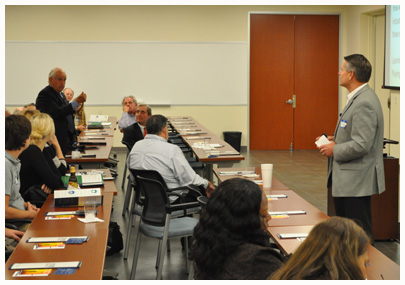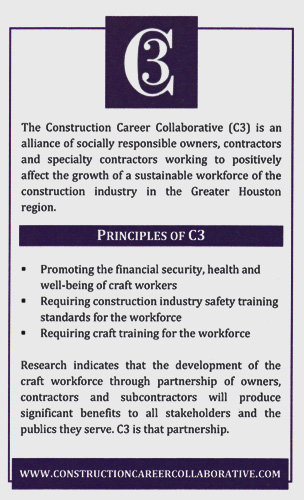 One of our bloggers, Pat Kiley, CEO of Kiley Advisors LLC and former president of the AGC in Houston, attended the recent screening of the Houston 2040 Scenarios presented by the Center for Houston’s Future.
One of our bloggers, Pat Kiley, CEO of Kiley Advisors LLC and former president of the AGC in Houston, attended the recent screening of the Houston 2040 Scenarios presented by the Center for Houston’s Future.
Here are his observations and comments.
I think all Construction Trade Associations and their members should see this presentation, and simultaneously learn about the Construction Career Collaborative (C3) and the Immigration Reform efforts.
Either of the two scenarios, or something in between, creates enormous opportunity and enormous challenge for our industry. The opportunity is to create the built environment required for an additional 3 million people in the Learning to Live Scenario or an additional 8 million in the Playing to Win Scenario. The challenge is to build the trained workforce that will be needed.
The amount of every type of construction work will be staggering; it will create a “next generation of success” for those firms that embrace and prepare for the opportunity. And, I am confident the industry will easily adapt to innovations in building products and processes that will evolve over the next 30 years.
The much bigger issue is creating the required workforce. We will need many more workers and a faster and more formal way to train them. In my judgment, it will be imperative to have legal access to an immigrant work force, and there must be structured craft training, with both high schools and junior colleges playing key roles. Without both of these elements in place, it will be hard to realize the opportunities of the very plausible options detailed in the scenarios.
The hard numbers position the challenge. To date in 2011, there has been an average of 178,000 construction employees, on payrolls each month, as reported to the Texas Workforce Commission (TWC). That number includes executives, professionals, administrative people and craft workers. The number has dropped from an average of just over 200,000 per month in 2008, the record market year. We all know there are many more construction workers that are paid by cash and not reported; we can only speculate what that number may be. But even if it is double the number reported in 2008, we were struggling then to man jobs and support a population of about 4.5 million people. With either Scenario for 2040, we will need to dramatically expand the workforce, especially at the craft level.
The training picture is an even steeper hill, exacerbated by retirements. It has been nearly 30 years since there was a lot of formal craft training for all but the Mechanical and Electrical Crafts. Many formally trained workers became crew leaders in open shop companies and now train new workers. They will be exiting in rather large numbers in the next 10 -15 years. (I see actuarial reports; the average age is now in the late 40’s; few construction trade workers make it to 65 to retire.) So the C3 Initiatives need to gain real traction with all trades, and soon.
When you consider all factors, the scale of the industry effort needed is massive. And, 30 years is a shorter horizon than it first sounds, when you digest all that needs to be done. We need to double or triple the size of the current craft work force and get them trained in the requisite craft skill, safety procedures and technology. To do that, we need access to immigrants for certain. And we need high school students to consider construction craft-work as a bona fide option, not as “a job of last resort”. To do that, we need competitive pay and benefit levels that allow construction work to be a true career, as it once was – one that provides dignity and pride. We do not want our industry workers to be classified as “the working poor” described in the scenario Playing to Win. Creating all these changes is a mega-project in the purest sense.
than it first sounds, when you digest all that needs to be done. We need to double or triple the size of the current craft work force and get them trained in the requisite craft skill, safety procedures and technology. To do that, we need access to immigrants for certain. And we need high school students to consider construction craft-work as a bona fide option, not as “a job of last resort”. To do that, we need competitive pay and benefit levels that allow construction work to be a true career, as it once was – one that provides dignity and pride. We do not want our industry workers to be classified as “the working poor” described in the scenario Playing to Win. Creating all these changes is a mega-project in the purest sense.
If the associations can provide forums to expose their members to an integrated look at both the future possibilities and the current realities, I think we can get real mobilization. The Scenarios will be the hook to elevate contractor interest; they offer some quantitative data that will energize builders. The C3 Initiative will be compelling on its face. The Immigration reform needs will be more obvious, and the work of Construction Citizen.com will be better understood, appreciated and supported.
I also hope our industry will ratchet up their support for the Center for Houston’s Future. It is a first rate organization with a strong board and staff, and their efforts directly benefit our industry.
Industry Leader Comments on 2040 Scenarios
by Pat Kiley | November 10, 2011



Comments
Fast track construction training
C3 is great first step to achieving your goal of educating our future construction workers. This needs to be a national effort with a coordinated structure for all the construction industry participants to get behind. We have to forget union/non-union biases, break down the political barriers, create an educational/training system that excites old & new workers to get involved in the trades, utilize the "Old Salts" whose vast knowledge will be gone soon, strategize the fastest, most efficient way to achieve it, and get it done NOW! The military has a great system of accelerated training techniques that we should customize to our training curriculm. They also have mothballed facilities that could be activated for that purpose. Put these recruits in "basic training" and get it done ... fast. You can't make a plumber in 2 weeks, but it certainly doesn't take 4 years of indentured servitude (slavery) either. I've been a Master Plumber for 40 years, owned my own business, and dealt with the lack of skilled tradesmen forever. So has everyone else reading this. When are we going to make the commitment to change this? Who is going to step up and be the leader(s)? Who/how are we going to fund it? We'd better hurry up, or we'll be back in the caves before you know it!
Add new comment